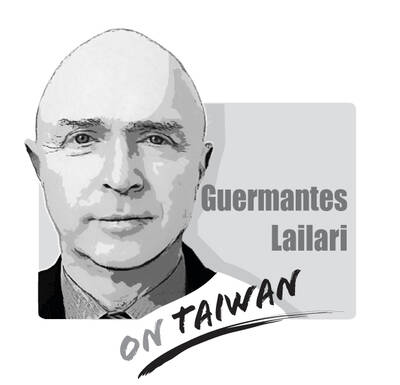Recent talks about ending the war in Ukraine have aroused attention around the globe. US President Donald Trump believes that Washington provides more aid than the EU, even though Ukraine’s security affects the bloc more than the US.
Trump therefore wants to reach an agreement with Ukraine to gain access to its rare earth materials as a condition for continued US support. This shows that Ukraine is not among the core interests of the US, which is why it is asking Kyiv for more benefits or hoping that the EU would take up greater responsibility for its defense.
In comparison, Taiwan occupies a critical position in the US’ interests in the fields of technology, the economy and the military.
In the technology sector, Taiwan occupies a global leading position. Taiwan Semiconductor Manufacturing Co’s 2-nanometer process technology has made it a vital part of the supply chain for the US’ artificial intelligence (AI) industry and military technology development. Competition between the US and China in AI is intense, and Taiwan’s high-tech enterprises are indispensable to the US’ development in this field.
In the military sector, Taiwan plays an important role in the US’ military strategy in the Indo-Pacific region because of its strategic location, deepening cooperation between the two countries.
Under the US’ 2023 National Defense Authorization Act (NDAA), US military advisers have been stationed in Kinmen and Penghu counties for regular training. Last year, the US Congress passed the 2025 NDAA which authorizes the Pentagon to provide up to US$300 million to promote the Taiwan Security Cooperation Initiative and to boost Taiwan’s defense capabilities. It also proposes inviting Taiwanese naval forces to participate in this year’s Rim of the Pacific exercise.
Under the Trump administration’s “America First” policy, the US has replaced “democratic values” with “exchanges of interests” as the standard for choosing allies. Trump has repeatedly said that Taiwan has “stolen” the semiconductor business from the US and threatened to impose tariffs.
To reduce the trade deficit with the US, Taiwan is considering increasing imports from the US, including liquefied natural gas and agricultural products, and to increase cooperation with the US in the military supply chain to demonstrate the two countries’ complementary strategic industries.
To show Taiwan’s determination to defend itself, President William Lai (賴清德) said on Feb. 14 after presiding over his first high-level national security meeting this year that the government aims to increase defense spending to more than 3 percent of GDP this year and to increase military cooperation with the US.
All these show that Taiwan is sending a signal to the US that it aims to build an alliance based on shared interests.
Taiwan is different from Ukraine. Taiwan’s development and security are indispensable to the US’ core interests. Under Trump’s administration, Taiwan has to proactively adjust its policies to show that it shares common interests with the US so that it can secure Washington’s direct and sustainable assistance.
Given their shared common interests, Taiwan and the US should not only increase military and economic cooperations, but also build a stronger alliance in areas such as supply chain security, emerging technologies and Internet safety. This is to ensure the two countries’ edge in global competitions and the ability to cope with regional and international challenges.
Lee Li-sheng is a graduate student at National Taiwan Normal University.
Translated by Fion Khan
A response to my article (“Invite ‘will-bes,’ not has-beens,” Aug. 12, page 8) mischaracterizes my arguments, as well as a speech by former British prime minister Boris Johnson at the Ketagalan Forum in Taipei early last month. Tseng Yueh-ying (曾月英) in the response (“A misreading of Johnson’s speech,” Aug. 24, page 8) does not dispute that Johnson referred repeatedly to Taiwan as “a segment of the Chinese population,” but asserts that the phrase challenged Beijing by questioning whether parts of “the Chinese population” could be “differently Chinese.” This is essentially a confirmation of Beijing’s “one country, two systems” formulation, which says that

“History does not repeat itself, but it rhymes” (attributed to Mark Twain). The USSR was the international bully during the Cold War as it sought to make the world safe for Soviet-style Communism. China is now the global bully as it applies economic power and invests in Mao’s (毛澤東) magic weapons (the People’s Liberation Army [PLA], the United Front Work Department, and the Chinese Communist Party [CCP]) to achieve world domination. Freedom-loving countries must respond to the People’s Republic of China (PRC), especially in the Indo-Pacific (IP), as resolutely as they did against the USSR. In 1954, the US and its allies
Indian Prime Minister Narendra Modi arrived in China yesterday, where he is to attend a summit of the Shanghai Cooperation Organization (SCO) with Chinese President Xi Jinping (習近平) and Russian President Vladimir Putin today. As this coincides with the 50 percent US tariff levied on Indian products, some Western news media have suggested that Modi is moving away from the US, and into the arms of China and Russia. Taiwan-Asia Exchange Foundation fellow Sana Hashmi in a Taipei Times article published yesterday titled “Myths around Modi’s China visit” said that those analyses have misrepresented India’s strategic calculations, and attempted to view
When Chinese President Xi Jinping (習近平) stood in front of the Potala Palace in Lhasa on Thursday last week, flanked by Chinese flags, synchronized schoolchildren and armed Chinese People’s Liberation Army (PLA) troops, he was not just celebrating the 60th anniversary of the establishment of the “Tibet Autonomous Region,” he was making a calculated declaration: Tibet is China. It always has been. Case closed. Except it has not. The case remains wide open — not just in the hearts of Tibetans, but in history records. For decades, Beijing has insisted that Tibet has “always been part of China.” It is a phrase